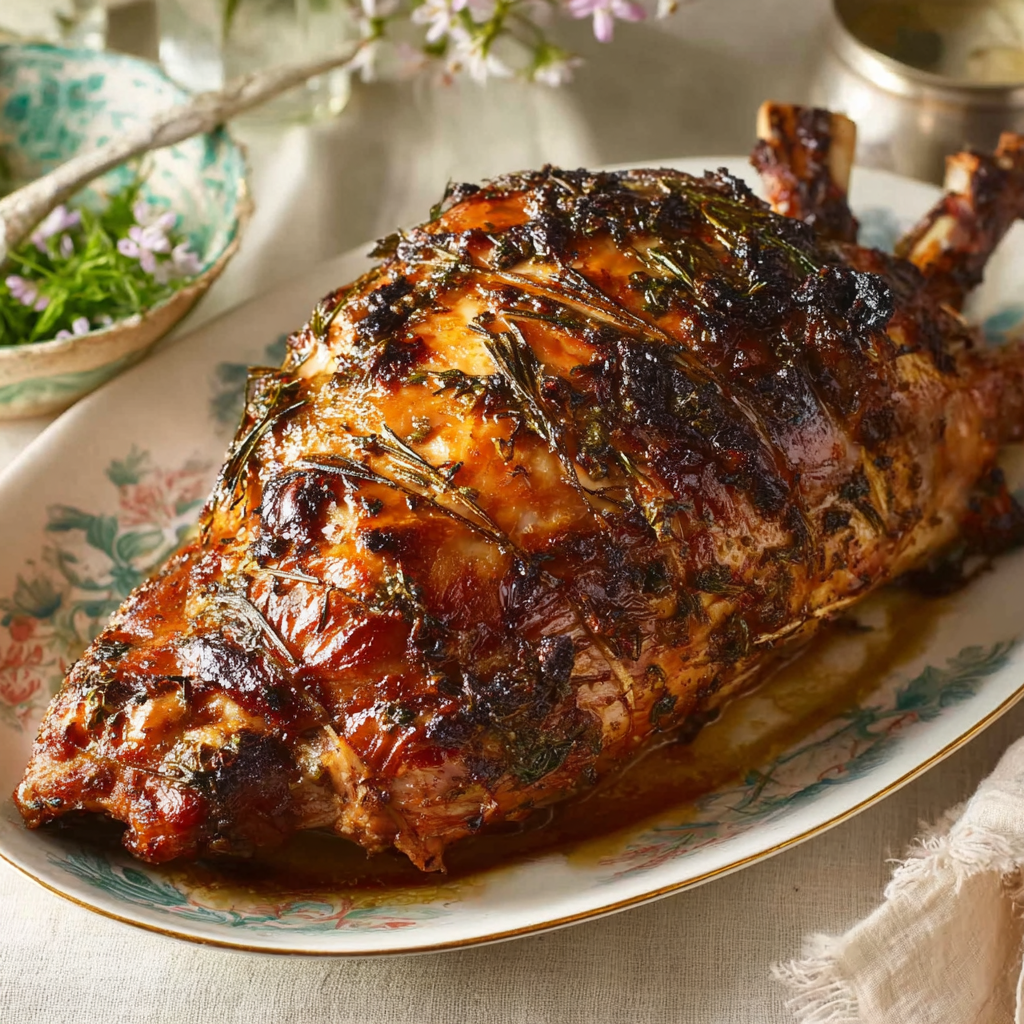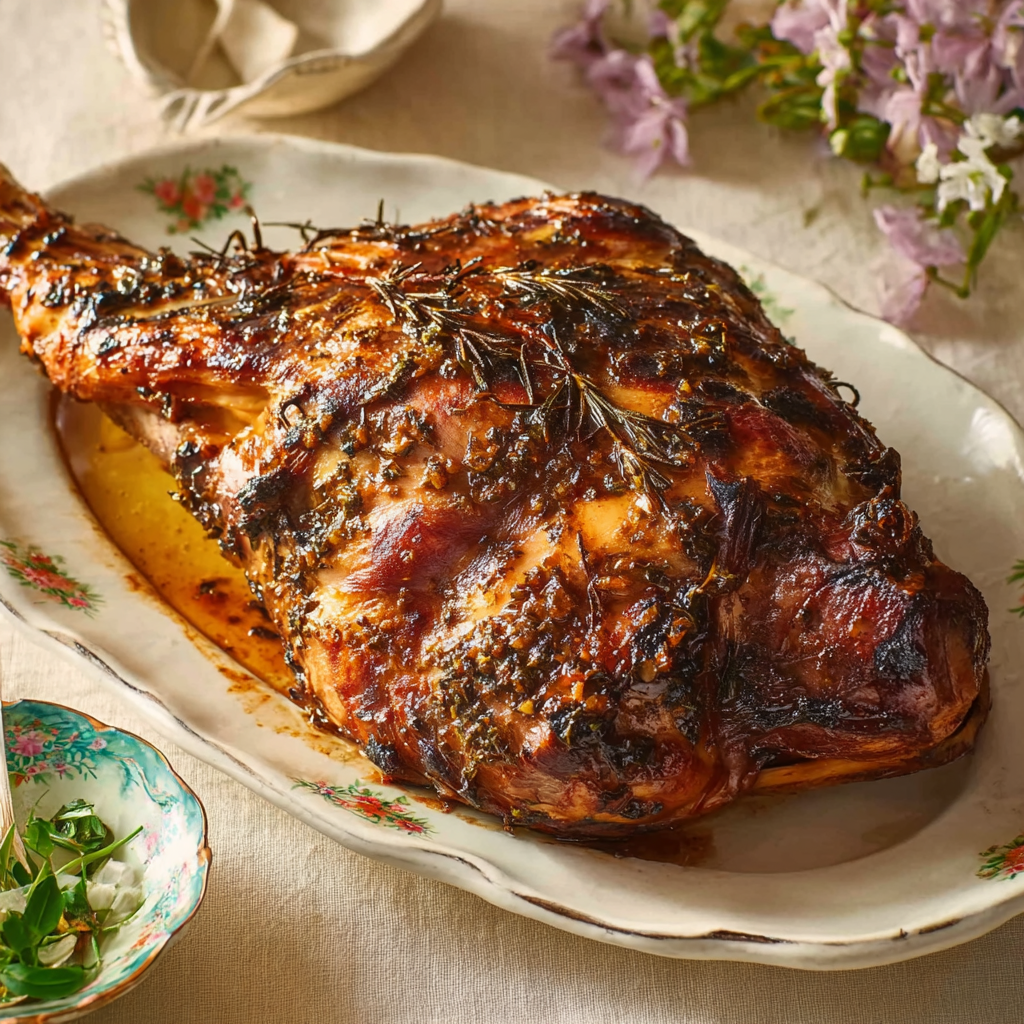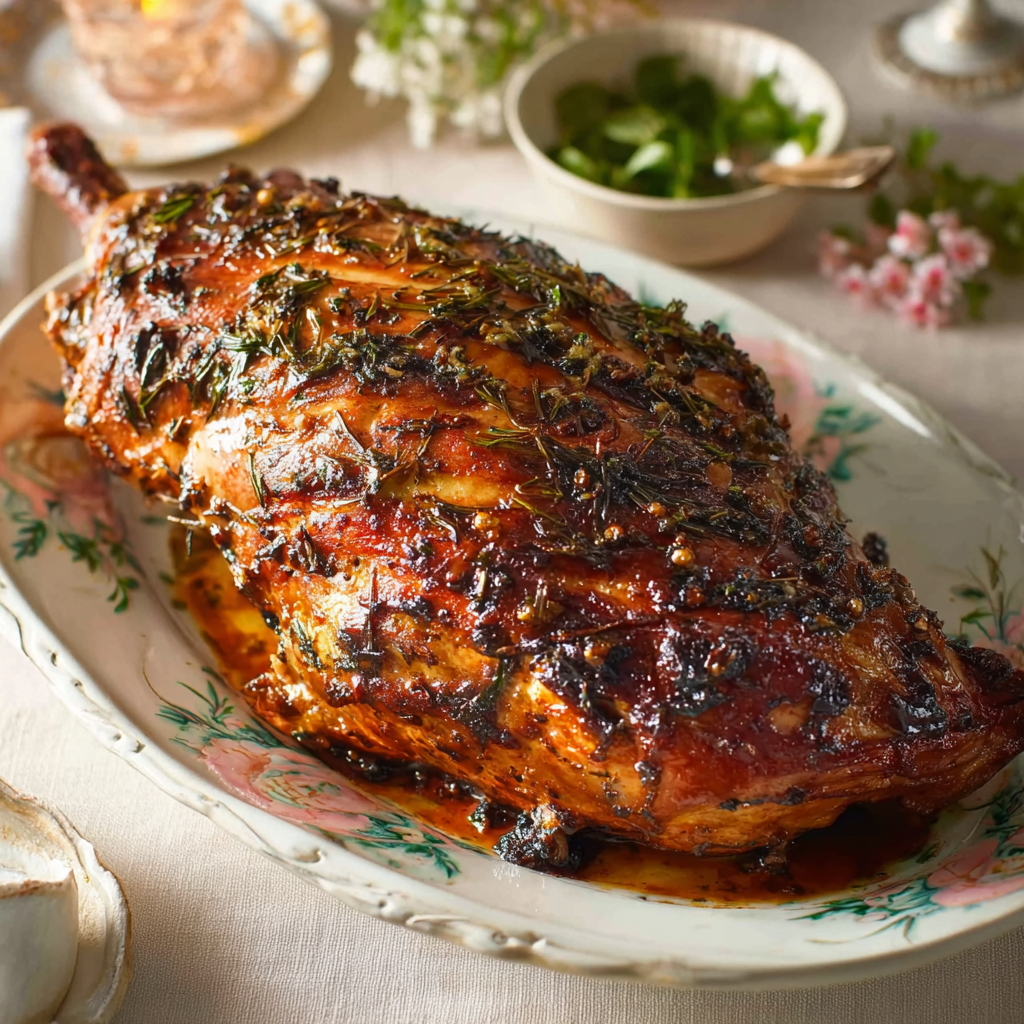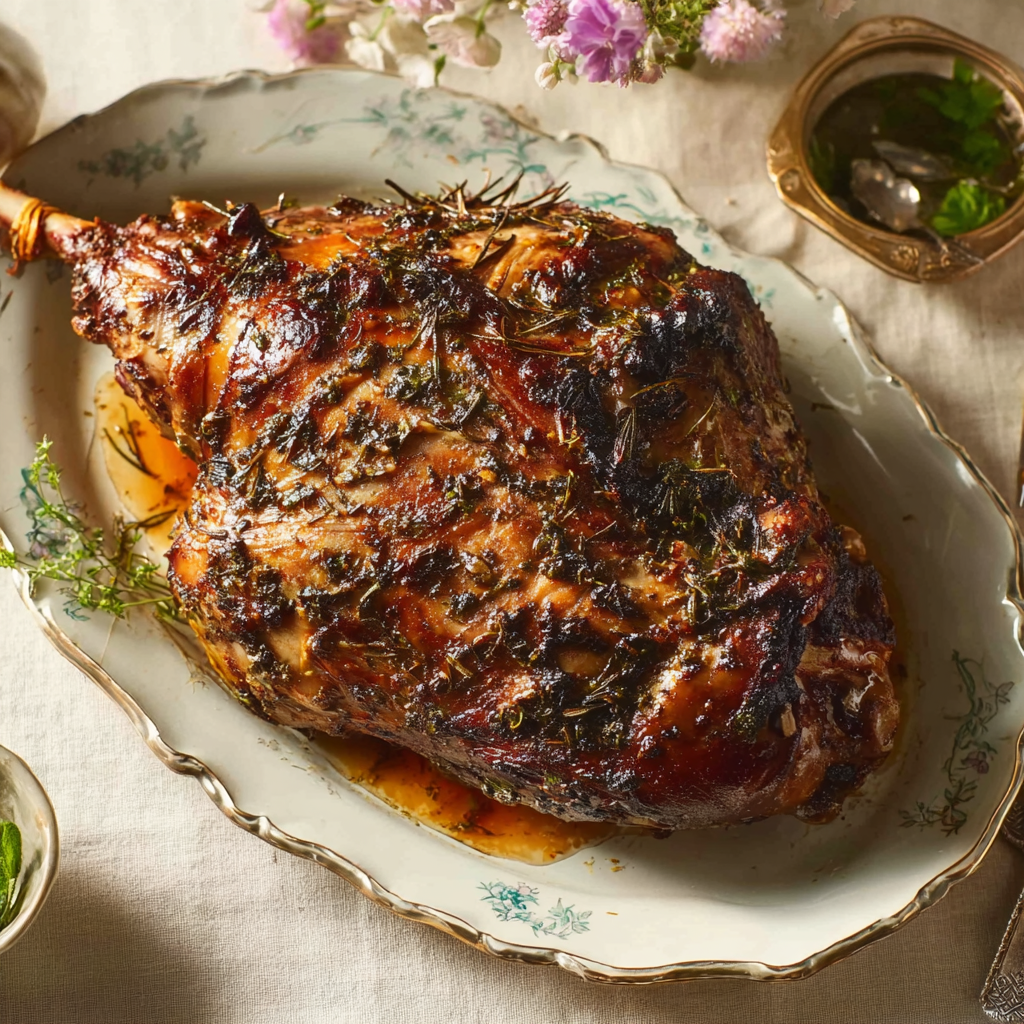1. Introduction to the Recipe
The 12-hour lamb shoulder roast recipe is a perfect example of how patience and simple ingredients come together to create a mouthwatering, melt-in-your-mouth experience. Slow-roasting a bone-in lamb shoulder for an extended period allows the meat to break down gently, resulting in incredibly tender, flavorful, and juicy lamb that practically falls off the bone. This method elevates a humble cut into a dish worthy of family dinners, special occasions, or weekend celebrations. The use of fresh rosemary, oregano, and garlic in the marinade infuses the meat with herbaceous, savory notes that complement lamb’s rich character beautifully.
One of the standout features of this recipe is its simplicity — just a handful of ingredients combined with a long, slow cooking process that lets the flavors develop naturally. Water and onion add moisture and sweetness, while a light jus made from the pan drippings enhances every bite. This recipe is ideal for anyone looking to create an impressive roast without fussing over complicated steps or frequent checking. For additional inspiration and tips on roasting lamb, you can explore a comprehensive lamb roasting guide. To learn more about seasoning blends that pair well with lamb, visit a Mediterranean herb marinade tips.
Slow cooking this lamb shoulder is a great way to prepare a large cut ahead of time, allowing the meat to rest and develop flavor for hours while you focus on other meal components. The result is a luscious, aromatic centerpiece that requires minimal effort but delivers maximum satisfaction. With this full guide, you’ll learn how to prepare the marinade, properly roast the lamb, and make a simple jus to serve alongside, plus advanced techniques to enhance texture and flavor, storage advice, dietary adaptations, and answers to common questions.
2. Basic Recipe: Ingredients and Instructions
Print
Roast Lamb Shoulder Recipe – Slow-Cooked 12-Hour Tender Lamb
Description
Slow-cook tender, flavorful lamb with this 12-hour lamb shoulder roast recipe featuring a rosemary garlic marinade and rich jus.
Ingredients
Lamb and Cooking
- 1.6 – 2.2 kg (3.2 – 4.4 lb) lamb shoulder, bone-in (Note 1)
- 2 cups water (Note 2)
- 1 brown onion (unpeeled), cut into 6 wedges (Note 3)
Marinade
- 2 ½ teaspoons fresh rosemary, finely chopped
- 1 tablespoon dried oregano
- 2 large garlic cloves, finely chopped
- 1 teaspoon salt (kosher or cooking salt, or ¾ teaspoon table salt)
- ½ teaspoon black pepper
- ¼ cup extra virgin olive oil
Jus for Serving
- 1 teaspoon cornflour (cornstarch)
- ¼ cup water
- ¼ teaspoon salt
Instructions
- Prepare the Marinade
In a small bowl, combine rosemary, oregano, garlic, salt, pepper, and olive oil. Mix well to form a paste. - Marinate the Lamb Shoulder
Rub the marinade evenly all over the lamb shoulder. Let it rest at room temperature for 30 minutes or refrigerate overnight for deeper flavor. - Preheat the Oven
Set your oven to 130°C (265°F) for slow roasting. - Prepare the Roasting Pan
Place the brown onion wedges and 2 cups of water in the base of a roasting pan or casserole dish. - Roast the Lamb
Place the lamb shoulder on top of the onions. Cover the roasting pan tightly with foil or a lid. - Slow Cook for 12 Hours
Roast in the oven for approximately 12 hours. The low temperature and slow cooking will render the lamb tender and juicy. - Make the Jus
After roasting, remove the lamb and keep warm. Pour the pan juices into a saucepan, skim excess fat, and bring to a simmer. Mix cornflour with water to make a slurry, add to the pan juices along with salt, and cook until slightly thickened. - Serve
Carve the lamb shoulder and serve with the warm jus.
Notes
Note 1: Choose a bone-in lamb shoulder for the best flavor and tenderness.
Note 2: The water helps create a moist cooking environment to prevent drying out.
Note 3: Leaving the onion unpeeled adds extra sweetness and depth to the jus.
3. Roast Lamb Shoulder Advanced Techniques
1. Using a Dry Brine for Deeper Flavor
Dry brining the lamb shoulder before applying the marinade can intensify its natural flavors and improve moisture retention. Rub salt evenly over the meat and let it rest uncovered in the refrigerator for 12–24 hours. This process enhances seasoning penetration and helps tenderize the meat’s outer layers. After dry brining, rinse lightly and pat dry before applying the herb marinade for best results.
2. Enhancing Aromatics with Roasting Vegetables
Adding more aromatics such as carrots, celery, and garlic cloves to the roasting pan increases the complexity of the jus. These vegetables caramelize slowly during the long roast, releasing natural sugars and flavor compounds. Strain the vegetables out when making the jus or mash them lightly and serve alongside the lamb for a rustic accompaniment.
3. Controlling Moisture: Using a Water Bath
For an even gentler cooking process, place the roasting pan inside a larger pan filled with hot water (a bain-marie). This technique regulates temperature and moisture levels, ensuring the lamb cooks evenly without drying. It’s especially useful if your oven’s temperature fluctuates or if you want ultra-tender results.
4. Resting the Lamb for Optimal Juiciness
After removing the lamb from the oven, let it rest covered loosely with foil for at least 30 minutes. Resting allows the meat fibers to relax and reabsorb juices, resulting in more tender and flavorful slices. Slicing immediately after cooking causes juices to run out, leading to drier meat.
5. Making a Pan Jus with Wine or Stock
To elevate the jus, deglaze the roasting pan with red wine or lamb stock before simmering the cornflour slurry. This adds layers of richness and complexity. Reduce the liquid slightly to concentrate flavor before thickening. Finish with a knob of butter for a glossy, velvety texture that perfectly complements the lamb.

4. Storage, Shelf Life, and Maintenance Tips
1. Refrigeration for Leftovers
Store leftover lamb shoulder in an airtight container in the refrigerator. The meat stays good for 3–4 days. To prevent drying, add some of the jus or pan juices when reheating. Gently warm in a low oven or microwave until heated through.
2. Freezing for Longer Storage
Cooked lamb shoulder freezes well for up to 3 months. Slice the meat before freezing for easy portioning. Wrap tightly in foil or freezer bags to prevent freezer burn. Thaw overnight in the fridge and reheat slowly with some pan juices to restore moisture.
3. Reheating Without Drying Out
Reheat lamb slices wrapped in foil at low heat (around 150°C/300°F) to maintain tenderness. Add a splash of water or broth inside the foil to create steam and prevent drying. Avoid high heat or microwaving uncovered, which causes toughness.
4. Storing Jus Separately
For best results, store the jus in a separate container from the meat. It can be refrigerated for 4–5 days or frozen for up to 1 month. Reheat gently before serving.
5. Using Leftover Lamb Creatively
Leftover slow-roasted lamb shoulder can be shredded or sliced for use in sandwiches, salads, or stews. The rich, tender meat adds delicious flavor to many dishes, extending the life of your roast and reducing waste.

5. Dietary Adaptations and Substitutions
1. Herb Variations for Different Flavor Profiles
While rosemary and oregano are classic with lamb, you can substitute or add herbs like thyme, mint, or sage to tailor the flavor. Mint especially pairs well with lamb and adds a fresh contrast to the rich meat.
2. Using Different Cuts of Lamb
If shoulder is unavailable, a leg of lamb or lamb shank can be slow-roasted similarly. Adjust cooking times accordingly—legs often require less time than shoulder, while shanks may need longer.
3. Gluten-Free and Paleo Considerations
This recipe is naturally gluten-free. For paleo diets, ensure the cornflour used for thickening the jus is replaced with arrowroot powder or omit thickening altogether and reduce the jus to desired consistency.
4. Low-Sodium Modifications
Reduce the amount of added salt or use low-sodium seasoning blends if you are monitoring sodium intake. Herbs and garlic help boost flavor without extra salt.
5. Dairy-Free Jus Option
If adding butter to finish the jus, substitute with olive oil or a dairy-free margarine to keep the dish dairy-free. The flavor remains rich and delicious without compromising texture.

6. FAQs About Roast Lamb Shoulder
1. Why Cook the Lamb Shoulder for 12 Hours?
Slow cooking at low temperature allows the connective tissues to break down, making the meat exceptionally tender and juicy. The long cook time is essential for that melt-in-your-mouth texture.
2. Can I Cook This Recipe in a Slow Cooker?
Yes, you can slow cook the lamb shoulder on low for 8–10 hours. Add the marinade and onions, place the lamb in the slow cooker with water, and cover. The texture will be similar, though you won’t get the roasted exterior.
3. How Do I Know When the Lamb is Done?
The lamb is done when it is fork-tender and easily pulls apart. Internal temperature should reach around 93°C (200°F) for pull-apart tenderness. Visual cues and tenderness are usually more important than precise temperature.
4. Can I Prepare the Marinade in Advance?
Absolutely. Marinading overnight enhances flavor infusion. You can also prepare the marinade paste and store it refrigerated for up to 3 days.
5. What Side Dishes Pair Well with This Roast?
Roasted vegetables, creamy mashed potatoes, or a fresh green salad complement the richness of the lamb beautifully. Mint yogurt sauce or chimichurri also add a bright contrast.

7. Conclusion & Final Thoughts
The 12-hour lamb shoulder roast recipe is a celebration of slow cooking at its finest. With minimal hands-on time and simple ingredients, it transforms a tough cut of meat into a luxurious centerpiece bursting with flavor and tenderness. The herbaceous marinade infuses the lamb with aromatic rosemary and oregano, while the slow roast softens the meat until it’s juicy and falling off the bone. The jus, made from pan drippings and thickened gently, ties the whole dish together with rich, savory depth.
This recipe’s beauty lies in its ease and the impressive results it yields, making it perfect for both casual family dinners and special occasions. The slow cooking method frees you from constant supervision, allowing you to focus on other parts of your meal or simply relax. Its versatility shines through in the ability to adjust herbs, cooking vessels, and sides to suit your preferences and needs. Plus, the leftovers provide countless opportunities for delicious new dishes.
In essence, slow-roasted lamb shoulder embodies comfort and sophistication simultaneously. It honors traditional roasting while welcoming modern convenience and flavor-enhancing techniques. If you’re looking to master a roast that impresses with flavor, texture, and aroma, this 12-hour lamb shoulder roast is a must-try recipe that will become a treasured part of your cooking repertoire.
